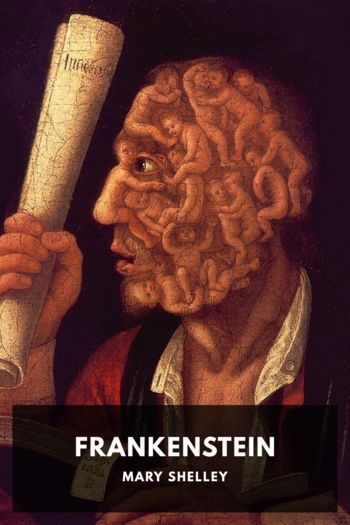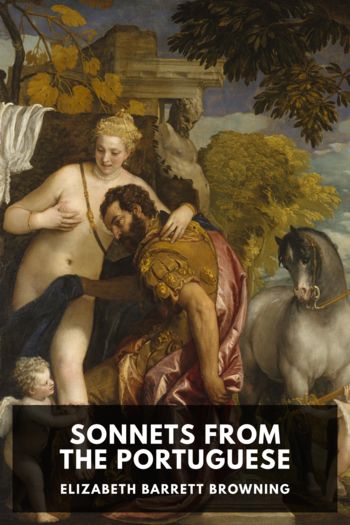Two-Way Mirror, Fiona Sampson [children's ebooks online .txt] 📗

- Author: Fiona Sampson
Book online «Two-Way Mirror, Fiona Sampson [children's ebooks online .txt] 📗». Author Fiona Sampson
He doesn’t need to worry. ‘Miss Bazy’ is taking months over her new poem precisely because she’s working hard on it. Not for her ‘effusions’ scribbled down in haste: she’ll never be a Romantic, even though this is the era of the Romantic second generation, and George Gordon Lord Byron and Percy Bysshe Shelley are poetry’s rising stars. She admires these figures not as peers but across the gulf that lies between writers and readers, although she’s only fourteen years Shelley’s junior. But her own tastes also hark back to what came before literary Romanticism, immersing her in the ancient Greek and Latin canon and guiding her towards poets, like Alexander Pope, who have already brought classical metres into English prosody.
Elizabeth wants to be an accomplished classicist as well as a poet, and she reconciles these twin ambitions through the belief that classical Greek scansion is the ideal form for English verse. The influence of this bifocalism will be enduring. For slowly, in the teenager’s bedroom with its country views, the famous future poet is being formed. Classical poetry feels authoritative and timeless to her. Both Pope’s straight-talking clarity and the plain speech of translation, which the classical tradition is in English, will find their way into her mature work. And, within this same tradition, extended narrative form passes from Homer, Virgil, Ovid and even Julius Caesar on its way to eighteenth-century pastiche in Pope’s The Dunciad and The Rape of the Lock, on through Byron’s Don Juan, which is being written and published even as Elizabeth sits here, and will eventually make space for the verse novel that is to be arguably her own most influential work.
All the same, in the high room at Hope End, she does also read Shelley, who drowned so shockingly this summer. His Adonais, on the death of John Keats, appeared last July while she was seriously ill in Gloucester, and must trigger intimate feelings of identification. It’s not surprising she describes it as an ‘exquisition’:
Within the twilight chamber spreads apace
The shadow of white Death, and at the door
Invisible Corruption waits.
For all her steely insistence on technique, she has a literary crush on Byron, too. Before she fell ill, she believed she would be ‘Very much in love when she was fifteen,—[…] Her lover was to be a poet in any case—and [she] was inclined to believe that he wd. be Ld. Byron.’
Only Bro seems to understand the deep division in her character that this marks. The intrinsically disobedient creativity of that wild girl, his boisterous sister Ba, hasn’t disappeared in the self-disciplined intellectual, the apparently obedient daughter, of their late teens. Elizabeth is both strong-willed and obedient, hot and cold, Dionysian and Apollonian. For her nineteenth birthday her favourite brother gives her ‘a very beautiful silver remember medal of Lord Byron’. ‘I was at a loss to discover which it most resembled Ld Byron, or myself’, he tells her, and while siblings may joke around, it’s a piece of striking self-identification by the blond, seventeen-year-old youth with the smouldering, infamous – and dead – peer; one which suggests an unspoken, intense intimacy.
And it is unusual for a teenaged boy to have his sister as best friend. But in these first years back at Hope End, Elizabeth, working through layers of loss – of health, independence, a chance at education – seems oblivious that Bro adores her, as she does of the possibility he jokingly suggests that ‘your friend Tommy’ Cooke, the Gloucester medic, has feelings for her. Poets are much safer targets for a crush than flesh-and-blood young men. Confined to the pages of books, Byron and Shelley can fill her imagination as pure visionaries, activists and role models. One of her first publishing successes, when she’s eighteen, is the appearance of her ‘Stanzas on the Death of Lord Byron’ in The Globe and Traveller:
He was, and is not! Graecia’s trembling shore,
Sighing through all her palmy groves, shall tell
That Harold’s pilgrimage at last is o’er—
It’s a virtuoso technical homage written in Spenserian stanzas, the exact form of Byron’s famous Bildungsroman, Childe Harold’s Pilgrimage – though, at only four stanzas to the original’s 555 pages, very much shorter. Such detail probably escapes her proud family. Elizabeth is visiting Cheltenham with Grandmama and Treppy when the poem appears, so Mamma reports:
Taking the paper, with a becoming carelessness of air, I asked [Papa] what he thought of those lines, he said, ‘They are very beautiful indeed the only I have seen at all worthy the subject.’ I cannot help thinking, replied I, that we know something of the Author. ‘They cannot be Ba’s’ said he, taking the paper from me to read them again, [‘]tho’ certainly when I first read them, they reminded me greatly of her style—had you any idea they are hers?[‘] ‘I have a conviction of it,’ said the conceited Mother, pouring out the tea with an air that threatened to overflow the tea tray.
As she grows stronger, Elizabeth will enjoy such stays away. A year after her return from Gloucester, the family decamped to the Normandy resort of Boulogne for seven months. Only eight years after the end of the Napoleonic Wars, Boulogne was already a popular bathing resort, though its prosperity still depended on herring. Eighteen months later in July 1825, and back across the Channel, Elizabeth and Henrietta go to live with Grandmama for almost a year in newly fashionable Hastings. These eighteen months at the seaside take Elizabeth away from her concentrated life at Hope End, but stamp her imagination. She’s at the lovely, responsive age when anything can change the way in which the self forms, and the ‘glorious sea! from side to side / Swinging the grandeur of his foamy strength’ will appear almost too frequently in the poems she goes on to write in her twenties.
But these are in the future. It’s while she’s at Hastings that Elizabeth’s second volume appears, three weeks after





Comments (0)